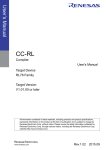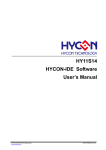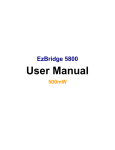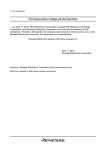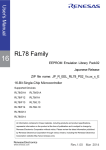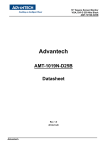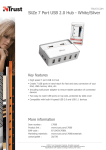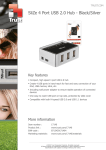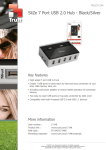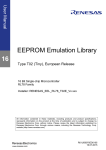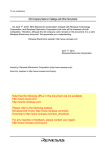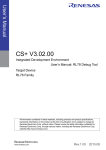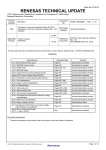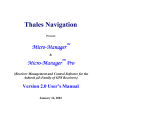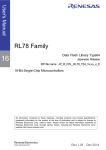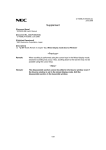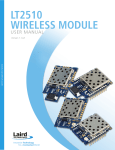Download RL78 Data Flash Access Library Type T02 (Tiny), European Release
Transcript
User Manual
Data Flash Access Library
16
16
Type T02 (Tiny), European Release
16 Bit Single-chip Microcontroller
RL78 Family
Installer:
RENESAS_FDL_RL78_T02E_Vx.xx
All information contained in these materials, including products and product specifications,
represents information on the product at the time of publication and is subject to change by
Renesas Electronics Corp. without notice. Please review the latest information published by
Renesas Electronics Corp. through various means, including the Renesas Technology Corp.
website (http://www.renesas.com).
All information contained in these materials, including products and product specifications,
represents information on the product at the time of publication and is subject to change by
R01US0061ED0120
Renesas Electronics Corp. without notice. Please review the latest information
published by
15.04.2015
Renesas
Electronics
Corp.
through
various
means,
including
the
Renesas
Technology
Corp.
www.renesas.com
website (http://www.renesas.com).
Data Flash Access Library - Type T02 (Tiny), European Release
Notice
Notice
1. All information included in this document is current as of the date this document is issued. Such information,
however, is subject to change without any prior notice. Before purchasing or using any Renesas Electronics
products listed herein, please confirm the latest product information with a Renesas Electronics sales office.
Also, please pay regular and careful attention to additional and different information to be disclosed by
Renesas Electronics such as that disclosed through our website.
2. Renesas Electronics does not assume any liability for infringement of patents, copyrights, or other
intellectual property rights of third parties by or arising from the use of Renesas Electronics products or
technical information described in this document. No license, express, implied or otherwise, is granted
hereby under any patents, copyrights or other intellectual property rights of Renesas Electronics or others.
3. You should not alter, modify, copy, or otherwise misappropriate any Renesas Electronics product, whether
in whole or in part.
4. Descriptions of circuits, software and other related information in this document are provided only to
illustrate the operation of semiconductor products and application examples. You are fully responsible for
the incorporation of these circuits, software, and information in the design of your equipment. Renesas
Electronics assumes no responsibility for any losses incurred by you or third parties arising from the use of
these circuits, software, or information.
5. When exporting the products or technology described in this document, you should comply with the
applicable export control laws and regulations and follow the procedures required by such laws and
regulations. You should not use Renesas Electronics products or the technology described in this
document for any purpose relating to military applications or use by the military, including but not limited to
the development of weapons of mass destruction. Renesas Electronics products and technology may not
be used for or incorporated into any products or systems whose manufacture, use, or sale is prohibited
under any applicable domestic or foreign laws or regulations.
6. Renesas Electronics has used reasonable care in preparing the information included in this document, but
Renesas Electronics does not warrant that such information is error free. Renesas Electronics assumes no
liability whatsoever for any damages incurred by you resulting from errors in or omissions from the
information included herein.
7. Renesas Electronics products are classified according to the following three quality grades: “Standard”,
“High Quality”, and “Specific”. The recommended applications for each Renesas Electronics product
depends on the product’s quality grade, as indicated below. You must check the quality grade of each
Renesas Electronics product before using it in a particular application. You may not use any Renesas
Electronics product for any application categorized as “Specific” without the prior written consent of
Renesas Electronics. Further, you may not use any Renesas Electronics product for any application for
which it is not intended without the prior written consent of Renesas Electronics. Renesas Electronics shall
not be in any way liable for any damages or losses incurred by you or third parties arising from the use of
any Renesas Electronics product for an application categorized as “Specific” or for which the product is not
intended where you have failed to obtain the prior written consent of Renesas Electronics.
R01US0061ED0120
User Manual
2
Data Flash Access Library - Type T02 (Tiny), European Release
Notice
8. The quality grade of each Renesas Electronics product is “Standard” unless otherwise expressly specified in
a Renesas Electronics data sheets or data books, etc.
“Standard”: Computers; office equipment; communications equipment; test and measurement equipment;
audio and visual equipment; home electronic appliances; machine tools; personal electronic
equipment; and industrial robots.
“High Transportation equipment (automobiles, trains, ships, etc.); traffic control systems; anti-disaster
Quality”: systems; anti- crime systems; safety equipment; and medical equipment not specifically
designed for life support.
“Specific”: Aircraft; aerospace equipment; submersible repeaters; nuclear reactor control systems; medical
equipment or systems for life support (e.g. artificial life support devices or systems), surgical
implantations, or healthcare intervention (e.g. excision, etc.), and any other applications or
purposes that pose a direct threat to human life.
9. You should use the Renesas Electronics products described in this document within the range specified by
Renesas Electronics, especially with respect to the maximum rating, operating supply voltage range,
movement power voltage range, heat radiation characteristics, installation and other product characteristics.
Renesas Electronics shall have no liability for malfunctions or damages arising out of the use of Renesas
Electronics products beyond such specified ranges.
10. Although Renesas Electronics endeavours to improve the quality and reliability of its products,
semiconductor products have specific characteristics such as the occurrence of failure at a certain rate and
malfunctions under certain use conditions. Further, Renesas Electronics products are not subject to
radiation resistance design. Please be sure to implement safety measures to guard them against the
possibility of physical injury, and injury or damage caused by fire in the event of the failure of a Renesas
Electronics product, such as safety design for hardware and software including but not limited to
redundancy, fire control and malfunction prevention, appropriate treatment for aging degradation or any
other appropriate measures. Because the evaluation of microcomputer software alone is very difficult,
please evaluate the safety of the final products or system manufactured by you.
11. Please contact a Renesas Electronics sales office for details as to environmental matters such as the
environmental compatibility of each Renesas Electronics product. Please use Renesas Electronics products
in compliance with all applicable laws and regulations that regulate the inclusion or use of controlled
substances, including without limitation, the EU RoHS Directive. Renesas Electronics assumes no liability
for damages or losses occurring as a result of your noncompliance with applicable laws and regulations.
12. This document may not be reproduced or duplicated, in any form, in whole or in part, without prior written
consent of Renesas Electronics.
13. Please contact a Renesas Electronics sales office if you have any questions regarding the information
contained in this document or Renesas Electronics products, or if you have any other inquiries.
Note 1 “Renesas Electronics” as used in this document means Renesas Electronics Corporation and
also includes its majority- owned subsidiaries.
Note 2 “Renesas Electronics product(s)” means any product developed or manufactured by or for
Renesas Electronics.
R01US0061ED0120
User Manual
3
Data Flash Access Library - Type T02 (Tiny), European Release
Regional information
Regional information
Some information contained in this document may vary from country to country. Before using any Renesas
Electronics product in your application, please contact the Renesas Electronics office in your country to obtain a
list of authorized representatives and distributors. They will verify:
Device availability
Ordering information
Product release schedule
Availability of related technical literature
Development environment specifications (for example, specifications for third-party tools and
components, host computers, power plugs, AC supply voltages, and so forth)
Network requirements
In addition, trademarks, registered trademarks, export restrictions, and other legal issues may also vary from
country to country.
Visit
http://www.renesas.com
to get in contact with your regional representatives and distributors.
R01US0061ED0120
User Manual
4
Data Flash Access Library - Type T02 (Tiny), European Release
Preface
Preface
Readers This manual is intended for users who want to understand the functions of the concerned
libraries.
Purpose This manual presents the software manual for the concerned libraries.
Numeric Binary:
notation
Decimal:
Hexadecimal
xxxx or xxxB
xxxx
xxxxH or 0x xxxx
Numeric Representing powers of 2 (address space, memory capacity):
prefix
K (kilo)
210 = 1024
M (mega):
220 = 10242 = 1,048,576
G (giga):
230 = 10243 = 1,073,741,824
Register X, x = don’t care
Diagrams Block diagrams do not necessarily show the exact software flow but the functional structure.
Timing diagrams are for functional explanation purposes only, without any relevance to the real
hardware implementation.
R01US0061ED0120
User Manual
5
Data Flash Access Library - Type T02 (Tiny), European Release
How to Use This Document
How to Use This Document
(1) Purpose and Target Readers
This manual is designed to provide the user with an understanding of the hardware functions and electrical
characteristics of the MCU. It is intended for users designing application systems incorporating the MCU. A
basic knowledge of electric circuits, logical circuits, and MCUs is necessary in order to use this manual. The
manual comprises an overview of the product; descriptions of the CPU, system control functions, peripheral
functions, and electrical characteristics; and usage notes.
Particular attention should be paid to the precautionary notes when using the manual. These notes occur within
the body of the text, at the end of each section, and in the Usage Notes section.
The revision history summarizes the locations of revisions and additions. It does not list all revisions. Refer to
the text of the manual for details.
(2) Related documents
Document number
Description
EEPROM Emulation Library Type T02 (Tiny), European
Release
R01AN1416EDxxxx
(3) List of Abbreviations and Acronyms
Abbreviation
Full form
Block
Smallest erasable unit of a flash macro
Code Flash
Embedded Flash where the application code is stored.
For devices without Data Flash EEPROM emulation
might be implemented on that flash in the so called
data area.
Data Flash
Embedded Flash where mainly the data of the
EEPROM emulation are stored. Beside that also code
operation might be possible.
Dual Operation
Dual operation is the capability to fetch code during
reprogramming of the flash memory. Current limitation
is that dual operation is only available between different
flash macros. Within the same flash macro it is not
possible!
EEL
EEPROM Emulation Library
EEPROM emulation
In distinction to a real EEPROM the EEPROM
emulation uses some portion of the flash memory to
emulate the EEPROM behavior. To gain a similar
behavior some side parameters have to be taken in
account.
FDL
Data Flash Library (Data Flash access layer)
Flash
“Flash EPROM” - Electrically erasable and
programmable nonvolatile memory. The difference to
ROM is, that this type of memory can be reprogrammed several times.
Flash Block
A flash block is the smallest erasable unit of the flash
memory.
R01US0061ED0120
User Manual
6
Data Flash Access Library - Type T02 (Tiny), European Release
Abbreviation
How to Use This Document
Full form
Flash Macro
A flash comprises of the cell array, the sense amplifier
and the charge pump (CP). For address decoding and
access some additional logic is needed.
NVM
Non volatile memory. All memories that hold the value,
even when the power is cut off. E.g. Flash memory,
EEPROM, MRAM...
RAM
“Random access memory” - volatile memory with
random access
ROM
“Read only memory” - nonvolatile memory. The content
of that memory can not be changed.
Serial programming
The onboard programming mode is used to program
the device with an external programmer tool.
Single Voltage
For the reprogramming of single voltage flashes the
voltage needed for erasing and programming are
generated onboard of the microcontroller. No external
voltage needed like for dual- voltage flash types.
All trademarks and registered trademarks are the property of their respective owners.
R01US0061ED0120
User Manual
7
Data Flash Access Library - Type T02 (Tiny), European Release
Table of Contents
Table of Contents
Chapter 1
Introduction ....................................................................... 10
1.1 Components of the EEPROM Emulation System ........................................ 11
1.1.1 Physical Flash Layer ............................................................................. 11
1.1.2 Flash Access Layer ............................................................................... 11
1.1.3 EEPROM Access Layer ......................................................................... 11
1.1.4 Application Layer ................................................................................... 11
Chapter 2
Architecture ....................................................................... 12
2.1 Data Flash Fragmentation ............................................................................. 12
2.1.1 EEL Pool ................................................................................................. 12
2.1.2 FDL Pool ................................................................................................. 12
2.2 Address Virtualization ................................................................................... 12
2.3 Access Right Supervision ............................................................................. 13
2.4 Request-Response Architecture................................................................... 15
2.5 Background Operation .................................................................................. 16
2.5.1 Background Operation: Erase .............................................................. 16
2.5.2 Background Operation: Internal-Verify and Blankcheck.................... 17
2.5.3 Background Operation (Write) .............................................................. 18
2.6 Abortion of Commands ................................................................................. 19
2.7 StandBy and WakeUp Functionality ............................................................. 21
Chapter 3
User Interface (API) ........................................................... 22
3.1 Run-time Configuration ................................................................................. 22
3.2 Data Types ...................................................................................................... 23
3.2.1 Library-specific simple Type Definitions ............................................. 23
3.2.2 Enumeration Type “fdl_command_t”................................................... 23
3.2.3 Enumeration Type “fdl_status_t” ......................................................... 24
3.2.4 Structured Type “fdl_request_t” .......................................................... 25
3.2.5 Structured Type “fdl_descriptor_t” ...................................................... 26
3.3 Functions ........................................................................................................ 28
3.3.1 FDL_Init .................................................................................................. 28
3.3.2 FDL_Open............................................................................................... 30
3.3.3 FDL_Close .............................................................................................. 32
3.3.4 FDL_Execute .......................................................................................... 34
3.3.5 FDL_Handler .......................................................................................... 36
3.3.6 FDL_Abort .............................................................................................. 38
3.3.7 FDL_StandBy ......................................................................................... 41
R01US0061ED0120
User Manual
8
Data Flash Access Library - Type T02 (Tiny), European Release
Table of Contents
3.3.8 FDL_WakeUp .......................................................................................... 43
3.3.9 FDL_GetVersionString .......................................................................... 45
3.4 Commands ..................................................................................................... 47
3.4.1 Blankcheck ............................................................................................. 47
3.4.2 Internal Verify ......................................................................................... 48
3.4.3 Read ........................................................................................................ 49
3.4.4 Write ........................................................................................................ 50
3.4.5 Erase ....................................................................................................... 51
3.5 Basic functional Workflow ............................................................................ 52
Chapter 4
FDL Usage by User Application ....................................... 53
4.1 First Steps ...................................................................................................... 53
4.2 Special Considerations ................................................................................. 53
4.2.1 Reset Consistency ................................................................................. 53
4.2.2 EEL+FDL or FDL only ............................................................................ 53
4.3 File Structure .................................................................................................. 54
4.4 Configuration.................................................................................................. 55
4.4.1 Linker Sections ...................................................................................... 55
4.4.2 Descriptor Configuration (Partitioning of the Data Flash) ................. 55
4.4.3 Prohibited RAM Area ............................................................................. 55
4.4.4 Register Bank ......................................................................................... 55
4.4.5 Stack and Data Buffer............................................................................ 56
4.4.6 Request Structure .................................................................................. 56
4.5 General Flow .................................................................................................. 56
4.5.1 Initialization ............................................................................................ 56
4.5.2 Read ........................................................................................................ 57
4.5.3 Blankcheck/Write/IVerify/Erase ............................................................ 58
4.6 Example of FDL used in Operating Systems ............................................... 59
4.7 Example: Simple application ........................................................................ 61
Chapter 5
Characteristics .................................................................. 62
5.1 Resource Consumption ................................................................................. 62
5.2 Library Timings .............................................................................................. 62
5.2.1 Maximum Function Execution Times ................................................... 62
5.2.2 Command Execution Times .................................................................. 64
Chapter 6
Cautions ............................................................................. 65
R01US0061ED0120
User Manual
9
Data Flash Access Library - Type T02 (Tiny), European Release
Chapter 1
Introduction
Introduction
This user’s manual describes the overall structure, functionality and software interfaces (API) of the Data
Flash Library T02 (Tiny) accessing the physical Data Flash separated and independent from the Code
Flash. This library supports dual operation mode where the content of the Data Flash is accessible (read,
write, erase) during instruction code execution.
The flash access layer is a layer of the EEPROM emulation system and encapsulates the low-level
access to the physical flash a secure way. In case of Data Flash, this layer is using the FDL. It provides a
functional socket for Renesas EEPROM emulation software.
user application
application layer
EEL API
hardware
software
EEPROM emulation library
(EEL)
EEPROM layer
FDL API
Data Flash library
(FDL)
flash access layer
Data Flash
physical flash layer
Figure 1: Components of the EEPROM emulation system
To boost the flexibility and the real-time characteristics of the library it offers only fast atomic functionality
to read, write and erase the Data Flash memory at smallest possible granularity. Beside the pure access
commands some maintenance functionality to check the quality of the flash content is also provided by
the library.
R01US0061ED0120
User Manual
10
Data Flash Access Library - Type T02 (Tiny), European Release
Introduction
1.1 Components of the EEPROM Emulation System
To achieve a high degree of encapsulation the EEPROM emulation system is divided into several layers
with narrow functional interfaces.
1.1.1 Physical Flash Layer
The FDL is accessing the Data Flash as a physical media for storing data in the EEPROM emulation
system. The Data Flash is a separate memory that can be accessed independent of the Code Flash
memory. This allows background access to data stored in the Data Flash during program execution
located in the code flash.
1.1.2 Flash Access Layer
The flash access layer is represented by the flash access library provided by Renesas. In case of devices
incorporating data-flash the Data Flash Library (FDL) is representing this layer. It offers all atomic
functionality to access the Data Flash. To isolate the data-flash access from the used flash-media this
layer (the FDL) is transforming the physical addresses into a virtual, linear address-room.
1.1.3 EEPROM Access Layer
The EEPROM layer allows read/write access to the Data Flash on an abstract level. It is represented by
a Renesas EEPROM Emulation Library (EEL) or alternatively any other, user specific implementation.
1.1.4 Application Layer
The application layer represents user’s application software that can freely access all visible (specified by
the API definition) commands. The EEPROM layer and the flash access layer can be used
simultaneously. The FDL manages the access rights to it in a proper way.
R01US0061ED0120
User Manual
11
Data Flash Access Library - Type T02 (Tiny), European Release
Chapter 2
Architecture
Architecture
This chapter describes the overall architecture of the Tiny FDL.
2.1 Data Flash Fragmentation
The physical address range of the Data Flash depends on the utilized hardware (e.g. for RL78/G13:
0xF1000 – 0xF1FFF). However, the logical fragmentation of the Data Flash can be configured within the
given range.
Following figure shows the logical fragmentation of RL78/G13 physical Data Flash.
0xF1FFF
Data Flash
FDL pool
Access by
application only
EEL pool
Access by
EEL only
0xF1000
Figure 2: Logical fragmentation of physical Data Flash
2.1.1 EEL Pool
The EEL pool is exclusively used by the Renesas EEPROM Emulation Library (EEL). In case the EEL is
not used the whole Data Flash can be reserved as FDL pool.
2.1.2 FDL Pool
The FDL pool is exclusively used by the application. In case of a proprietary EEPROM emulation
implementation (user specific), the complete FDL pool has to be configured as FDL-pool.
2.2 Address Virtualization
To facilitate the access to the FDL pool, the physical addresses were virtualized. The virtualized pool
looks like a simple one-dimensional array.
R01US0061ED0120
User Manual
12
Data Flash Access Library - Type T02 (Tiny), European Release
Architecture
FDL/EEL
Pool
Data Flash
0xF2FFF
0x0FFF
Block 7
Block 3
0xF2C00
0x0C00
0xF2BFF
0x0BFF
Block 6
Block 2
0xF2800
0x0800
0xF27FF
0x07FF
Block 5
Block 1
0xF2400
0xF23FF
Block 4
0xF2000
FDL pool
Flash block
and address
transformation
0x0400
0x03FF
Block 0
0x0000
0xF1FFF
Block 3
0xF1C00
0xF1BFF
Block 2
0xF1800
EEL pool
0xF17FF
Block 1
0xF1400
0xF13FF
Block 0
0xF1000
Physical
address
virtual
byte
index
Figure 3: Relationship between physical and virtual pool addresses
2.3 Access Right Supervision
As mentioned before, the complete Data Flash is divided into two parts which are accessable by pool
owner (FDL does not allow user access to the EEL-pool and vice versa).
R01US0061ED0120
User Manual
13
Data Flash Access Library - Type T02 (Tiny), European Release
Architecture
USER
N-1
FDL pool
FDL pool access
)
-1
(N
0
N flash bytes
0x0000
FDL
EEL pool
EEL pool access
EEL
Figure 4: FDL pool access supervision
R01US0061ED0120
User Manual
14
Data Flash Access Library - Type T02 (Tiny), European Release
Architecture
2.4 Request-Response Architecture
The communication between the requester (user) and the executor (here the FDL) is a structured request
variable. The requester can specify the request and pass it to the FDL. After acceptance, the progress of
the execution can be checked by polling the request status.
From execution-time point of view the commands of the FDL are divided into two groups:
commands that can be aborted: block oriented commands like erase taking relatively long time for
its execution
commands that cannot be aborted: byte-oriented commands like write, read ... taking very short
time for its execution
Depending on the real-time requirements, the user can decide if independent, quasi-parallel execution of
block and byte commands is required or not. In such a case, two separate request-variables have to be
defined and managed by the application. Please refer to chapter “Basic functional Workflow” for details.
Following figure shows the access from requester and FDL point of view.
Requester
INDEX
DATA POINTER
BYTE COUNT
COMMAND
STATUS
FDL
Figure 5: Request oriented communication between FDL and its requester
R01US0061ED0120
User Manual
15
Data Flash Access Library - Type T02 (Tiny), European Release
Architecture
2.5 Background Operation
The flash technology provided by Renesas enables the application to write/erase the Data Flash in
parallel to the CPU execution. Such a feature is a powerful especially in operation systems were each
task could start FDL commands which will be executed in the background during task switching.
2.5.1 Background Operation: Erase
The erase command is the longest command. Once started, the erase command is executed in the
background leaving the user the option to execute other application tasks in the meantime. By calling the
FDL_Handler, the current progress of the command can be checked via the status of the used request
structure. As shown in the figure below, the application has the possibility to execute other user code
during the background operation.
USER
FDL
Data Flash
hardware
(background)
FDL_Execute(req.command_enu =
FDL_CMD_ERASE_BLOCK)
req.status_enu =
FDL_BUSY
FDL_Handler()
req.status_enu =
FDL_BUSY
FDL_Handler()
Erase
req.status_enu =
FDL_BUSY
FDL_Handler()
req.status_enu =
FDL_BUSY
FDL_Handler()
req.status_enu =
FDL_OK
Figure 6: Background operation (Erase)
R01US0061ED0120
User Manual
16
Data Flash Access Library - Type T02 (Tiny), European Release
Architecture
2.5.2 Background Operation: Internal-Verify and Blankcheck
Just like the erase command, also the internal verify and the blankcheck are performed in the
background, once they have been triggered.
USER
FDL
Data Flash
hardware
(background)
FDL_Execute(req.command_enu =
FDL_CMD_IVERIFY_BYTES or
FDL_CMD_BLANKCHECK_BYTES)
req.status_enu =
FDL_BUSY
Blank-Check(x bytes)
OR
Internal Verify (x bytes)
FDL_Handler()
req.status_enu =
FDL_BUSY
FDL_Handler()
req.status_enu =
FDL_OK
Figure 7: Background operation (Internal-Verify/Blankcheck)
R01US0061ED0120
User Manual
17
Data Flash Access Library - Type T02 (Tiny), European Release
Architecture
2.5.3 Background Operation (Write)
Compared to the erase/verify/blankcheck command the write commands, is running only partially in the
background. Each byte is written in the background whereas the administrative part of selecting the next
byte is done by the FDL_Handler(). Therefore, it is mandatory to call the FDL_Handler not only for
checking the current progress, but also to drive the command forward.
USER
FDL
Data Flash
hardware
(background)
FDL_Execute(req.command_enu =
FDL_CMD_WRITE_BYTES)
req.status_enu =
FDL_BUSY
Write
Byte (1)
FDL_Handler()
req.status_enu =
FDL_BUSY
Write
Byte (2)
FDL_Handler()
req.status_enu =
FDL_BUSY
Write
Byte (3)
::::
::::
::::
::::
FDL_Handler()
req.status_enu =
FDL_BUSY
Write
Byte (x)
FDL_Handler()
req.status_enu =
FDL_OK
Figure 8: Background operation (Write)
R01US0061ED0120
User Manual
18
Data Flash Access Library - Type T02 (Tiny), European Release
Architecture
2.6 Abortion of Commands
Some application scenarios require an immediate abort of running data flash operations e.g. in cases of
voltage drop or emergency data write to the data flash. For that reason the FDL provides an abort
mechanism where a running erase command can be aborted immediately. The following figure shows
such an scenario.
USER
FDL
Data Flash
hardware
(background)
FDL_Execute(req.command_enu =
FDL_CMD_ERASE_BLOCK)
Erase
req.status_enu =
FDL_BUSY
FDL_Abort()
::::
req.status_enu =
FDL_ERR_ABORTED
FDL_Abort() returns
FDL_OK
Figure 9: Abort erase command
As shown in the figure above, the erase command will be immediately aborted in case of calling the
FDL_Abort function and the requester of the erase command will be informed that the requested
command was aborted. In such a case, the command shall be re-started by requester later. In contrast,
the blankcheck/write/verify commands cannot be aborted immediately and therefore have to be finished
by repeated calls of the FDL_Abort function. The following figure shows the abort functions in case of
blankcheck/write/verify commands.
R01US0061ED0120
User Manual
19
Data Flash Access Library - Type T02 (Tiny), European Release
USER
FDL
Architecture
Data Flash
hardware
(background)
FDL_Execute(req.command_enu =
FDL_CMD_BLANKCHECK_BYTES**)
req.status_enu =
FDL_BUSY
::::
::::
FDL_Abort()
Blank-Check
or
Write
FDL_Abort()
returns FDL_BUSY
or
Internal Verify
FDL_Abort()
FDL_Abort()
returns FDL_BUSY
FDL_Abort()
FDL_Abort()
returns FDL_OK
** same procedure for FDL_CMD_WRITE_BYTES and FDL_CMD_IVERIFY_BYTES
Figure 10: Abort Blankcheck/Write/Internal Verify command
R01US0061ED0120
User Manual
20
Data Flash Access Library - Type T02 (Tiny), European Release
Architecture
2.7 StandBy and WakeUp Functionality
The StandBy and WakeUp feature provides the possibility to temporarily turn off the data flash
functionality including the hardware (e.g. for power consumption) and resume the functionality. The
StandBy mode is active in case the FDL_StandBy function returns FDL_OK. In case the return status is
FDL_BUSY any command is running and FDL_StandBy function has to be re-called. The following figure
shows the sequence of using the StandBy/WakeUp feature.
USER
FDL
Data Flash
hardware
(background)
FDL_Execute(req.command_enu =
FDL_CMD_BLANKCHECK_BYTES**)
req.status_enu =
FDL_BUSY
Blank-Check
or
::::
::::
Write
FDL_StandBy()
or
FDL_StandBy()
returns FDL_BUSY
FDL_StandBy()
Internal Verify
or
Erase
FDL_StandBy()
returns FDL_OK
FDL_WakeUp()
DFLEN* = 1
FDL_WakeUp()
returns FDL_OK
* Data Flash enable SFR
** same procedure for FDL_CMD_ERASE_BLOCK, FDL_CMD_WRITE_BYTES and
FDL_CMD_IVERIFY_BYTES
Figure 11: StandBy and WakeUp sequence
Note: It is not allowed to call any FDL function other than FDL_WakeUp and FDL_Handler when FDL is
in StandBy mode.
R01US0061ED0120
User Manual
21
Data Flash Access Library - Type T02 (Tiny), European Release
Chapter 3
User Interface (API)
User Interface (API)
3.1 Run-time Configuration
The configuration of the FDL can be changed dynamically at runtime. Thereby, more than one descriptor
constant has to be defined by the user in advance. Depending on the application different descriptors can
be used for the FDL_Init(...) function.
/*
/*
/*
................... */
some code
*/
................... */
/* load standard descriptor */
my_status=FDL_Init(&fdl_descriptor_str);
/*
/*
/*
................... */
some code
*/
................... */
EEL_Close();
FDL_Close();
/* load alternative descriptor
*/
my_status=FDL_Init(&fdl_descr_2_str);
/*
/*
/*
................... */
some code
*/
................... */
Note: Before changing FDL pool configuration by using a different FDL pool-descriptor, the user has to
finish all running FDL and EEL commands and close the FDL via the FDL_Close() function.
R01US0061ED0120
User Manual
22
Data Flash Access Library - Type T02 (Tiny), European Release
User Interface (API)
3.2 Data Types
This chapter describes all data definitions used by the TinyFDL. In order to reduce the probability of type
mismatches in the user application, please make strict usage of the provided types and avoid using
standard data types instead.
3.2.1 Library-specific simple Type Definitions
This type defines simple numerical type used by the library
typedef unsigned char
typedef unsigned int
typedef unsigned long int
fdl_u08;
fdl_u16;
fdl_u32;
3.2.2 Enumeration Type “fdl_command_t”
The enumeration type fdl_command_t defines all allowed codes used to specify library commands. This
type is used within the structure fdl_request_t (see Section 3.2.4) in order to specify which command shall
be executed via the function FDL_Execute. A detailed description of each command can be found in
Section 3.4.
typedef enum
{
FDL_CMD_READ_BYTES
FDL_CMD_IVERIFY_BYTES
FDL_CMD_BLANKCHECK_BYTES
FDL_CMD_WRITE_BYTES
FDL_CMD_ERASE_BLOCK
} fdl_command_t;
=
=
=
=
=
(0x00),
(0x01),
(0x02),
(0x03),
(0x04)
Note: Due to the fact that the library has been implemented in Assembler, it is mandatory that the
enumeration type fdl_command_t has a size of exactly 1 byte. The GNU compiler uses 16-bit
enumeration types by default. Therefore, for GNU compiler, the declaration of the enumeration type has
to be extended with an attribute in order to be compiled to 1 byte:
“__attribute__ ((__packed__))”.
Table 1: Command codes
Command
Description
FDL_CMD_READ_BYTES
reads data from flash memory
FDL_CMD_IVERIFY_BYTES
verifies data if flash provides full data retention
FDL_CMD_BLANKCHECK_BYTES
checks if flash content is erased
FDL_CMD_WRITE_BYTES
writes data into flash memory
FDL_CMD_ERASE_BLOCK
erases one flash block
R01US0061ED0120
User Manual
23
Data Flash Access Library - Type T02 (Tiny), European Release
User Interface (API)
3.2.3 Enumeration Type “fdl_status_t”
This enumeration type defines all possible status- and error-codes can be generated during data-flash
access via the FDL. The FDL_OK and FDL_BUSY status are returned to the requester during normal
operation. Other codes signalize problems.
On the one hand, fdl_status_t is used as return type of the functions FDL_Init (see Section 3.3.1),
FDL_Abort (see Section 3.3.6), FDL_StandBy (see Section 3.3.7) and FDL_WakeUp (see Section 3.3.8).
On the other hand, fdl_status_t is used within the structure fdl_request_t (see Section 3.2.4) in order to
capture the processing of currently running command. Thereby, the possible error codes are command
specific and described in detail in Section 3.4 along with the commands.
typedef enum
{
FDL_OK
FDL_BUSY
FDL_ERR_INITIALIZATION
FDL_ERR_REJECTED
FDL_ERR_ABORTED
FDL_ERR_PARAMETER
FDL_ERR_STANDBY
FDL_ERR_ERASE
FDL_ERR_BLANK_VERIFY
FDL_ERR_WRITE
FDL_ERR_CONFIGURATION
} fdl_status_t;
=
=
=
=
=
=
=
=
=
=
=
(0x00),
(0xFF),
(0x02),
(0x03),
(0x04),
(0x05),
(0x06),
(0x1A),
(0x1B),
(0x1C),
(0x01)
Note: Due to the fact that the library has been implemented in Assembler, it is mandatory that the
enumeration type fdl_status_t has a size of exactly 1 byte. The GNU compiler uses 16-bit enumeration
types by default. Therefore, for GNU compiler, the declaration of the enumeration type has to be
extended with an attribute in order to be compiled to 1 byte:
“__attribute__ ((__packed__))”.
Table 2: Enumeration type "fdl_status_t" details
Status value
Description
FDL_OK
Command finished without problems
FDL_BUSY
Command is being processed
FDL_ERR_INITIALIZATION
FDL_Init()/FDL_Open() missing
FDL_ERR_REJECTED
Request could not be accepted
FDL_ERR_ABORTED
Erase command has been aborted
FDL_ERR_PARAMETER
Parameter error
FDL_ERR_STANDBY
FDL_WakeUp missing
FDL_ERR_ERASE
Erase error
FDL_ERR_BLANK_VERIFY
Blank- or verify error
FDL_ERR_WRITE
Write error
FDL_ERR_CONFIGURATION
Pool or frequency configuration wrong
R01US0061ED0120
User Manual
24
Data Flash Access Library - Type T02 (Tiny), European Release
User Interface (API)
3.2.4 Structured Type “fdl_request_t”
This type is used for definition of request variables and used for information exchange between the
application and the FDL. A request variable is passed to the FDL to initiate a command and can be used
by the requester (EEL, application...) to check the status of its execution. Not every element of this
structure is required for each command. However, all members of the request variable must be initialized
once before usage. Please refer to Section 3.4 for a more detailed description and the command-specific
usage of the structure elements.
/* FDL request type (base type for any FDL access) */
typedef struct
{
fdl_u16
index_u16;
_near fdl_u08*
data_pu08;
fdl_u16
bytecount_u16;
fdl_command_t
command_enu;
fdl_status_t
status_enu;
} fdl_request_t;
Note: The GNU compiler does not require the “__near” keyword to declare near pointers. All pointers are
near by default as long as the “__far” keyword is not used.
Table 3: Structured type "fdl_request_t" details
Struct member
Description
Start address of the target area:
index_u16
Erase: virtual block number inside FDL-pool
Read/write/blankcheck/internal verify: virtual
byte number inside FDL-pool
data_pu08
Pointer to the first byte of the data buffer to be
written or read. Only used for read/write commands.
bytecount_u16
Number of bytes to be transferred starting from the
start byte specified in index_u16. The byte count
range is from 1 byte to 1024 bytes. Please note, that
the execution of the read/write/blankcheck/internal
verify command across block boundaries is not
allowed. This struct member is not required for erase
command.
command_enu
Command code to be executed
status_enu
Request status code (feedback)
R01US0061ED0120
User Manual
25
Data Flash Access Library - Type T02 (Tiny), European Release
User Interface (API)
3.2.5 Structured Type “fdl_descriptor_t”
This type defines the structure of the FDL descriptor. It contains all characteristics of the FDL. It is used in
the fdl_descriptor.c sample file for definition of the ROM constant fdl_descriptor_str.
Based on configuration data inside the fdl_descriptor.h the initialization data of descriptor constant is
generated automatically in the fdl_descriptor.c.
/* FDL descriptor type */
typedef struct
{
fdl_u16
eel_pool_bytes_u16;
fdl_u16
fdl_pool_bytes_u16;
fdl_u16
fdl_delay_u16;
fdl_u08
eel_pool_blocks_u08;
fdl_u08
fdl_pool_blocks_u08;
fdl_u08
fx_MHz_u08;
fdl_u08
wide_voltage_mode_u08;
} fdl_descriptor_t;
Table 4: Structured type "fdl_descriptor_t" details
Struct member
Description
eel_pool_bytes_u16
EEL-pool size in bytes.
It shall be computed by the compiler pre-processor based on
the following formula:
DATA_FLASH_BLOCK_SIZE* eel_pool_blocks_u08
DATA_FLASH_BLOCK_SIZE is the physical size of a Flash
block specified in the device HW user manual.
fdl_pool_bytes_u16
FDL-pool size in bytes
It shall be computed by the compiler pre-processor based on
the following formula:
DATA_FLASH_BLOCK_SIZE* eel_pool_blocks_u08
DATA_FLASH_BLOCK_SIZE is the physical size of a Flash
block specified in the device HW user manual.
fdl_delay_u16
Constant delay depending on configured frequency.
It shall be computed by the compiler pre-processor by the
following formula:
(10 * fx_MHz_u08) / 6
eel_pool_blocks_u08
EEL-pool size in blocks.
It shall be chosen by the user with the condition that
(fdl_pool_blocks_u08 + eel_pool_blocks_u08) may not exceed
the size of the data flash specified in the device HW user
manual.
fdl_pool_blocks_u08
FDL-pool size in blocks.
It shall be chosen by the user with the condition that
(fdl_pool_blocks_u08 + eel_pool_blocks_u08) may not exceed
the size of the data flash specified in the device HW user
manual.
R01US0061ED0120
User Manual
26
Data Flash Access Library - Type T02 (Tiny), European Release
Struct member
User Interface (API)
Description
CPU frequency
fx_MHz_u08
Frequency must be rounded up as follows:
descr.fx_MHz_u08 =
((FDL_SYSTEM_FREQUENCY+999999)/1000000)
FDL_SYSTEM_FREQUENCY specifies the device frequency
and not the HOCO (internal high-speed on-chip oscillator)
frequency.
In case the frequency is smaller than 4MHz the only supported
physically frequencies by FDL are the following:
1MHz=1000000Hz, 2MHz=2000000Hz and 3MHz=3000000Hz
Programming voltage mode (full/wide).
It shall be chosen by the user:
wide_voltage_mode_u08
R01US0061ED0120
User Manual
wide_voltage_mode_u08 shall be set to 1 for wide
voltage mode
wide_voltage_mode_u08 shall be set to 0 for full speed
voltage mode.
For details of the voltage mode, refer to the user’s manual of
the target RL78 microcontroller.
27
Data Flash Access Library - Type T02 (Tiny), European Release
User Interface (API)
3.3 Functions
3.3.1 FDL_Init
Outline: Initialization of the Flash Data Library.
Interface: C Interface for CA78K0R Compiler
fdl_status_t
__far FDL_Init(const __far fdl_descriptor_t*
descriptor_pstr)
C Interface for IAR Compiler
__far_func fdl_status_t FDL_Init(const __far fdl_descriptor_t __far*
descriptor_pstr)
C Interface for GNU Compiler
fdl_status_t
FDL_Init(const fdl_descriptor_t __far* descriptor_pstr)
__attribute__ ((section ("FDL_CODE")))
C Interface for CC-RL Compiler
fdl_status_t __far FDL_Init(const __far fdl_descriptor_t*
descriptor_pstr);
ASM function label
FDL_Init
Arguments: Parameters
Argument
Type
Access
descriptor_pstr
fdl_descriptor_t* (far)
R
Passed via
CA78K0R
IAR
GNU
CC-RL
BC(highw),
AX(loww)
stack
stack
A(high),
DE(loww)
Pointer to the descriptor (describing the FDL configuration). The virtualization of the dataflash address-room is done based on that descriptor. The user can use different
descriptors to switch between different FDL-pool configurations.
R01US0061ED0120
User Manual
28
Data Flash Access Library - Type T02 (Tiny), European Release
User Interface (API)
Return value
Passed via
Type
CA78K0R IAR
fdl_status_t
C
A
GNU
CC-RL
R8
A
(X bank 1)
FDL_ERR_CONFIGURATION when descriptor is not plausible.
FDL_OK when descriptor is plausible and initialization was successful.
Destructed registers
Tool chain
Destructed registers
CA78K0R
AX, B
IAR
AX, HL, CS, ES
GNU
None
CC-RL
X, BC, DE, HL
Pre- Internal high-speed oscillator is running.
conditions:
Post- Initialization is done.
conditions:
Description: Several checks are performed during the initialization:
plausibility check of the pool configuration
frequency parameter check against supported device-specific range
initialization of all internal variables
initialization of the flash firmware
configuration of HOCO
After initialization, the FDL remains passive. FDL_Open() has to be executed to open
access to the FDL pool.
Note: It is not allowed to call FDL_Init in case of any running FDL command.
Example:
fdl_status_t my_status;
my_status = FDL_Init(&fdl_descriptor_str);
if(my_status == FDL_OK)
{
/* FDL can be used */
}
else
{
/* error handler */
}
R01US0061ED0120
User Manual
29
Data Flash Access Library - Type T02 (Tiny), European Release
User Interface (API)
3.3.2 FDL_Open
Outline: Activation of the data-flash.
Interface: C Interface for CA78K0R Compiler
void __far FDL_Open(void)
C Interface for IAR Compiler
__far_func void FDL_Open(void)
C Interface for GNU Compiler
void
FDL_Open(void) __attribute__ ((section ("FDL_CODE")))
C Interface for CC-RL Compiler
void __far FDL_Open(void)
ASM function label
FDL_Open
Arguments: Parameters
none
Return value
none
Destructed registers
Tool chain
Destructed registers
CA78K0R
None
IAR
None
GNU
None
CC-RL
AX
Pre- The initialization shall be done before. However, no check is performed here. If the FDL is
conditions: not yet initialized, FDL_Open() has no functionality.
Post- Data flash clock is switched on.
conditions:
Description: This function must be used by the application to activate the data-flash.
R01US0061ED0120
User Manual
30
Data Flash Access Library - Type T02 (Tiny), European Release
User Interface (API)
Example:
FDL_Open();
R01US0061ED0120
User Manual
31
Data Flash Access Library - Type T02 (Tiny), European Release
User Interface (API)
3.3.3 FDL_Close
Outline: Deactivation of the data-flash.
Interface: C Interface for CA78K0R Compiler
void __far FDL_Close(void)
C Interface for IAR Compiler
__far_func void FDL_Close(void)
C Interface for GNU Compiler
void FDL_Close(void) __attribute__ ((section ("FDL_CODE")))
C Interface for CC-RL Compiler
void __far FDL_Close(void)
ASM function label
FDL_Close
Arguments: Parameters
none
Return value
none
Destructed registers
Tool chain
Destructed registers
CA78K0R
None
IAR
None
GNU
None
CC-RL
C
Pre- The library initialization and open via FDL_Init and FDL_Open shall be done before
conditions: calling this function. If FDL is not yet activated the FDL_Close() has no functionality.
Post- Data flash clock is switched off. All hardware background activities will be stopped
conditions: immediately.
R01US0061ED0120
User Manual
32
Data Flash Access Library - Type T02 (Tiny), European Release
User Interface (API)
Description: This function must be used by the application to deactivate the data-flash.
Example:
FDL_Close();
R01US0061ED0120
User Manual
33
Data Flash Access Library - Type T02 (Tiny), European Release
User Interface (API)
3.3.4 FDL_Execute
Outline: Initiates the execution of an FDL command.
Interface: C Interface for CA78K0R Compiler
void __far FDL_Execute(__near fdl_request_t* request_pstr)
C Interface for IAR Compiler
__far_func void FDL_Execute(__near fdl_request_t __near* request_pstr)
C Interface for GNU Compiler
void FDL_Execute(fdl_request_t* request_pstr)
__attribute__ ((section ("FDL_CODE")))
C Interface for CC-RL Compiler
void __far FDL_Execute(__near fdl_request_t* request_pstr)
ASM function label
FDL_Execute
Arguments: Parameters
Argument
request_pstr
Type
Access
fdl_request_t* (near)
RW
Passed via
CA78K0R
AX
IAR
AX
GNU
CC-RL
stack
AX
This argument defines the command which should be executed by FDL. It is a request
variable which is used for bidirectional information exchange before and during execution
between FDL and the application. For details please refer to the “Request-Response
Architecture” chapter.
Return value
none
Destructed registers
Tool chain
Destructed registers
CA78K0R
AX
IAR
AX, HL, CS, ES
GNU
None
CC-RL
AX, BC, DE, HL
R01US0061ED0120
User Manual
34
Data Flash Access Library - Type T02 (Tiny), European Release
User Interface (API)
Pre- The library initialization and open via FDL_Init and FDL_Open shall be done before
conditions: calling this function.
Post- None
conditions:
Description: This is the main function of the FDL which can be used inside of the application to initiate
the execution of any command. Please refer to the chapter “Commands” for detailed
explanation of each command.
Note 1: Although there are commands that do not require all request structure elements
to be specified, the whole structure needs to be initialized before calling EEL_Execute.
Otherwise, a RAM parity error may cause a reset of the device. For details, please refer
to the document “User's Manual: Hardware” of your RL78 product.
Note 2: The request structure used for execution has to be word-aligned, i.e. located at
an even memory address.
Example:
__near fdl_request_t my_fdl_request_str;
__near fdl_u08 buffer[4];
buffer[0] = {0x01, 0x23, 0x45, 0x67};
my_fdl_request.index_u16 = 0x0000;
my_fdl_request.data_pu08 = (__near fdl_u08*)buffer;
my_fdl_request.bytecount_u16 = 0x0004;
my_fdl_request.command_enu = FDL_CMD_WRITE_BYTES;
/* command initiation */
do
{
FDL_Execute(&my_fdl_request);
FDL_Handler(); /* proceed background process */
}
while (my_fdl_request.status_enu == FDL_ERR_REJECTED);
/* command execution */
do
{
FDL_Handler();
}
while (my_fdl_request.status_enu == FDL_BUSY);
if(my_fdl_request.status_enu != FDL_OK)
{
error_handler();
}
R01US0061ED0120
User Manual
35
Data Flash Access Library - Type T02 (Tiny), European Release
User Interface (API)
3.3.5 FDL_Handler
Outline: Function for command proceeding.
Interface: C Interface for CA78K0R Compiler
void __far FDL_Handler(void)
C Interface for IAR Compiler
__far_func void FDL_Handler(void)
C Interface for GNU Compiler
void FDL_Handler(void) __attribute__ ((section ("FDL_CODE")))
C Interface for CC-RL Compiler
void __far FDL_Handler(void)
ASM function label
FDL_Handler
Arguments: Parameters
none
Return value
none
Destructed registers
Tool chain
Destructed registers
CA78K0R
None
IAR
None
GNU
None
CC-RL
A, C, HL
Pre- The library initialization and open via FDL_Init and FDL_Open shall be done before
conditions: calling this function.
Post- In case of finished command the status is written to the request structure associated to
conditions: the currently running command.
R01US0061ED0120
User Manual
36
Data Flash Access Library - Type T02 (Tiny), European Release
User Interface (API)
Description: This function is used by the application to proceed the execution of a running command
initiated by FDL_Execute function.
Example:
/* infinite scheduler loop */
do
{
/* proceed potential command execution */
FDL_Handler();
/* 20ms time slize (potential FDL requester) */
MyTask_A(20);
/* 10ms time slize (potential FDL requester) */
MyTask_B(10);
/* 40ms time slize (potential FDL requester) */
MyTask_C(40);
/* 10ms time slize (potential FDL requester) */
MyTask_D(10);
}
while (true);
R01US0061ED0120
User Manual
37
Data Flash Access Library - Type T02 (Tiny), European Release
User Interface (API)
3.3.6 FDL_Abort
Outline: Function for erase command abortion.
Interface: C Interface for CA78K0R Compiler
fdl_status_t __far FDL_Abort(void)
C Interface for IAR Compiler
__far_func fdl_status_t FDL_Abort(void)
C Interface for GNU Compiler
fdl_status_t FDL_Abort(void) __attribute__ ((section ("FDL_CODE")))
C Interface for CC-RL Compiler
fdl_status_t __far FDL_Abort(void)
ASM function label
FDL_Abort
Arguments: Parameters
none
Return value
Passed via
Type
CA78K0R IAR
fdl_status_t
C
A
GNU
CC-RL
R8
A
(X bank 1)
FDL_OK when either no command is running or erase has been aborted.
FDL_BUSY when byte oriented command is still running.
Destructed registers
Tool chain
Destructed registers
CA78K0R
None
IAR
None
GNU
None
CC-RL
BC, HL
R01US0061ED0120
User Manual
38
Data Flash Access Library - Type T02 (Tiny), European Release
User Interface (API)
Pre- The library initialization and open via FDL_Init and FDL_Open shall be done before
conditions: calling this function.
Post- In case of a running erase the command will be aborted and requester will be informed
conditions: via the request status FDL_ERR_ABORTED.
Description: This function enables the application to abort a running erase command (independent of
the affected pool) immediately. The requester will be informed regarding the stopped
erase via the request status FDL_ERR_ABORTED. In such a case the application shall
re-start the erase command otherwise the block cannot be used. Other commands like
blankcheck, write and verify cannot be aborted and therefore have to be finished properly.
If the application calls this function during the above described byte commands the return
value FDL_BUSY will be returned. That means a byte command is still running. Please
re-call the FDL_Abort functions as long as the status is FDL_BUSY. Only when the return
value is changed to FDL_OK the command is properly finished.
Example:
__near fdl_request_t
__near fdl_u08
my_fdl_request_str;
cmd_finished = 0;
/* request structure initialization */
my_fdl_request.index_u16
= 0x0000;
my_fdl_request.data_pu08
= (__near fdl_u08*) 0x0000;
my_fdl_request.bytecount_u16
= 0x0000;
my_fdl_request.command_enu
= (fdl_command_t)0xFF;
my_fdl_request.status_enu
= FDL_ERR_PARAMETER;
/* set erase command */
my_fdl_request.index_u16
my_fdl_request.command_enu
= 0x0000;
= FDL_CMD_ERASE_BLOCK;
/* ################# TASK 1 #################### */
/* ######## TRY TO ERASE HERE ONE BLOCK ######## */
/* ############################################# */
FDL_Execute(&my_fdl_request);
cmd_finished = 0;
while (cmd_finished == 0)
{
switch (my_fdl_request.status_enu)
{
case FDL_BUSY:
FDL_Handler();
break;
case FDL_ERR_ABORTED:
/* start erase again in case it was aborted */
FDL_Execute(&my_fdl_request);
FDL_Handler();
break;
case FDL_ERR_REJECTED:
/* try again if request not accepted */
FDL_Execute(&my_fdl_request);
FDL_Handler();
break;
default:
cmd_finished = 1;
break;
}
}
R01US0061ED0120
User Manual
39
Data Flash Access Library - Type T02 (Tiny), European Release
User Interface (API)
if (my_fdl_request.status_enu != FDL_OK)
{
error_handler();
}
/* #################### TASK 2 ####################### */
/* ######## WILL BE USED FOR EMERGENCY WRITE ######## */
.....
do
{
abort_status = FDL_Abort();
}
while( abort_status != FDL_OK);
DRIVER IS NO MORE BUSY HERE.
PERFORM EMERGENCY WRITE HERE ....................
R01US0061ED0120
User Manual
40
Data Flash Access Library - Type T02 (Tiny), European Release
User Interface (API)
3.3.7 FDL_StandBy
Outline: Function to drive the library into StandBy mode.
Interface: C Interface for CA78K0R Compiler
fdl_status_t __far FDL_StandBy(void)
C Interface for IAR Compiler
__far_func fdl_status_t FDL_StandBy(void)
C Interface for GNU Compiler
fdl_status_t FDL_StandBy(void) __attribute__ ((section ("FDL_CODE")))
C Interface for CC-RL Compiler
fdl_status_t __far FDL_StandBy(void)
ASM function label
FDL_StandBy
Arguments: Parameters
none
Return value
Passed via
Type
CA78K0R
fdl_status_t
C
IAR
A
GNU
CC-RL
R8
A
(X bank 1)
FDL_OK when FDL entered StandBy mode.
FDL_BUSY any command is still running.
Destructed registers
Tool chain
Destructed registers
CA78K0R
None
IAR
None
GNU
None
CC-RL
C, HL
R01US0061ED0120
User Manual
41
Data Flash Access Library - Type T02 (Tiny), European Release
User Interface (API)
Pre- The library initialization and open via FDL_Init and FDL_Open shall be done before
conditions: calling this function.
Post- Data flash clock is switched off and library is in StandBy mode.
conditions:
Description: The main purpose of this function is to drive the library and Data Flash into the StandBy
mode. StandBy mode means that
the Data Flash hardware is switched off (the DFLEN bit of the Data flash control
register is cleared), and
the library does not accept any command requests
Note: It is not allowed to call any FDL function other than FDL_WakeUp and
FDL_Handler when FDL is in StandBy mode.
Example:
do
{
standby_status = FDL_StandBy();
}
while (standby_status != FDL_OK);
#######################################
E.G. ENTER STOP/HALT MODE HERE ........
#######################################
wakeup_status = FDL_WakeUp();
if(wakeup_status != FDL_OK)
{
flow_error_handler();
}
E.G. CONTINUE WITH LIBRARY/APPLICATION EXECUTION HERE ...............
R01US0061ED0120
User Manual
42
Data Flash Access Library - Type T02 (Tiny), European Release
User Interface (API)
3.3.8 FDL_WakeUp
Outline: Function to wake up the library from StandBy mode.
Interface: C Interface for CA78K0R Compiler
__far_func fdl_status_t FDL_WakeUp(void)
C Interface for IAR Compiler
fdl_status_t __far FDL_WakeUp(void)
C Interface for GNU Compiler
fdl_status_t FDL_WakeUp(void) __attribute__ ((section ("FDL_CODE")))
C Interface for CC-RL Compiler
__far_func fdl_status_t FDL_WakeUp(void)
ASM function label
FDL_WakeUp
Arguments: Parameters
none
Return value
Passed via
Type
CA78K0R IAR
fdl_status_t
C
A
GNU
CC-RL
R8
A
(X bank 1)
FDL_OK when FDL is up and running.
FDL_ERR_REJECTED when library isn't in StandBy mode.
Destructed registers
Tool chain
Destructed registers
CA78K0R
None
IAR
None
GNU
None
CC-RL
X
R01US0061ED0120
User Manual
43
Data Flash Access Library - Type T02 (Tiny), European Release
User Interface (API)
Pre- The library initialization and open via FDL_Init and FDL_Open shall be done before
conditions: calling this function.
Post- Data flash clock is switched on and library is up and running.
conditions:
Description: The main purpose of this function is to wake-up the library and Data Flash hardware from
the StandBy mode. After successful execution of this function,
the Data Flash hardware is switched on(the DFLEN bit of the Data flash control
register is set), and
the FDL accepts new command requests.
Example:
wakeup_status = FDL_WakeUp();
if(wakeup_status != FDL_OK)
{
flow_error_handler();
}
E.G. CONTINUE WITH LIBRARY EXECUTION HERE ...............
R01US0061ED0120
User Manual
44
Data Flash Access Library - Type T02 (Tiny), European Release
User Interface (API)
3.3.9 FDL_GetVersionString
Outline: Function for reading library version information.
Interface: C Interface for CA78K0R Compiler
__far fdl_u08* __far FDL_GetVersionString(void)
C Interface for IAR Compiler
__far_func fdl_u08 __far* FDL_GetVersionString(void)
C Interface for GNU Compiler
fdl_u08 __far* FDL_GetVersionString(void)
__attribute__ ((section ("FDL_CODE")))
C Interface for CC-RL Compiler
__far fdl_u08* __far FDL_GetVersionString(void)
ASM function label
FDL_GetVersionString
Arguments: Parameters
none
Return value
Passed via
Type
fdl_u08* (far)
CA78K0R
IAR
GNU
CC-RL
DE(highw),
BC(loww)
A, HL
R8-R11
(AX, BC
bank 1)
A(high),
DE(loww)
Pointer to the first character of a zero terminated version string.
Destructed registers
Tool chain
Destructed registers
CA78K0R
None
IAR
None
GNU
None
CC-RL
None
R01US0061ED0120
User Manual
45
Data Flash Access Library - Type T02 (Tiny), European Release
User Interface (API)
Pre- None
conditions:
Post- None
conditions:
Description: For version control at runtime the developer can use this function to find the starting
character of the library version string.
The version string is a zero-terminated string constant that covers library-specific
information and is based on the following structure: NMMMMTTTCCCCCXVVV..V,
where:
N
: library type specifier (here ‘D’ for FDL)
MMMM
: series name of microcontroller (here ‘RL78’)
TTT
: type number (here T02)
CCCCC
: compiler information
‘Rxyy_’ for CA78K0R compiler version x.yy
‘Ixyy_’ for IAR compiler version x.yy
‘Uxxyy’ for GNU compiler version xx.yy
‘Lxyyz’ for CC-RL compiler version x.yy.0z
X
: memory/register models (here ‘G’ for general, i.e. all memory models)
VVV..V
: library version
Examples:
The version string of the Tiny FDL V1.00 for the CA78K0R compiler version 1.10 is:
"DRL78T02R110_GV100"
The version string of the Tiny FDL V1.00 for the IAR compiler version 1.20 is:
"DRL78T02I120_GV100"
The version string of the Tiny FDL V1.01 for the GNU compiler version 13.02 is:
"DRL78T02U1302GV101"
The version string of the Tiny FDL V1.01 for the CC-RL compiler version 1.23.04 is:
"DRL78T02L1234GV101"
Example:
my_version_string_pointer = FDL_GetVersionString();
R01US0061ED0120
User Manual
46
Data Flash Access Library - Type T02 (Tiny), European Release
User Interface (API)
3.4 Commands
3.4.1 Blankcheck
The blankcheck command can be used to check if all bits within the addressed range are still “erased”
e.g. before initiating a write. The blankcheck command is initiated by FDL_Execute() and must be
continued by FDL_Handler() as long as command is not finished (request status updated).
Note: Due to the fact that the blankcheck command execution across block boundaries is not allowed the
byte count range vary between 1 byte up to 1024 bytes.
Table 5: Request variable usage for blankcheck command
index_u16
byte index
inside the FDL pool
data_pu08
bytecount_u16
byte count
(1 byte to 1024 bytes)
unused
command_enu
FDL_CMD_
BLANKCHECK_BYTES
Table 6: Status of FDL_CMD_BLANKCHECK_BYTES
Status
FDL_ERR_INITIALIZATION
FDL_ERR_STANDBY
FDL_ERR_PARAMETER
FDL_ERR_BLANK_VERIFY
FDL_ERR_REJECTED
FDL_BUSY
FDL_OK
R01US0061ED0120
User Manual
Class
heavy
heavy
heavy
light
normal
normal
normal
Status meaning and handling
meaning
FDL not initialized or not opened
reason
wrong handling on user side
remedy
initialize and open FDL before using it
meaning
FDL is in standby and cannot accept new
commands
reason
wrong handling on user side
remedy
call FDL_WakeUp() before initiating new
commands
meaning
request cannot be accepted
reason
wrong command code, index outside the used
pool or request data structure on odd address
remedy
correct affected request member and try again
meaning
at least one byte within the specified pool area
is not “blank”
reason
any bit in the addressed flash area is not
erased
remedy
nothing, free interpretation at requester side
meaning
request cannot be accepted
reason
other command is being executed
remedy
call FDL_Handler() and try again
meaning
request is being processed
reason
request checked and accepted
remedy
nothing, call FDL_Handler() until status
changes
meaning
request was finished regular
reason
no problems during execution
remedy
nothing
47
Data Flash Access Library - Type T02 (Tiny), European Release
User Interface (API)
3.4.2 Internal Verify
The internal verify command can be used to check if all bits (0’s and 1’s) are electronically correct written.
Inconsistent and weak data caused by an asynchronous RESET can be detected by using the internal
verify command. The user can use the verify command freely to check the quality of user data. The
internal verify command is initiated by FDL_Execute() and must be continued by FDL_Handler() as long
as command is not finished (request-status updated).
Note: An execution of internal verify commands across block boundaries is not allowed. As a result the
byte count can range from 1 byte up to 1024 byte.
Table 7: Request variable usage for internal verify command
index_u16
byte index
inside the FDL pool
data_pu08
bytecount_u16
byte count
(1 byte to 1024 bytes)
unused
command_enu
FDL_CMD_IVERIFY_
BYTES
Table 8: Status of FDL_CMD_IVERIFY_BYTES
Status
FDL_ERR_INITIALIZATION
FDL_ERR_STANDBY
FDL_ERR_PARAMETER
FDL_ERR_BLANK_VERIFY
FDL_ERR_REJECTED
FDL_BUSY
FDL_OK
R01US0061ED0120
User Manual
Class
heavy
heavy
heavy
light
normal
normal
normal
Status meaning and handling
meaning
FDL not initialized or not opened
reason
wrong handling on user side
remedy
initialize and open FDL before using it.
meaning
FDL is in standby and cannot accept new
commands
reason
wrong handling on user side
remedy
call FDL_WakeUp() before initiating new
commands
meaning
request cannot be accepted
reason
wrong command code, index outside the used
pool or request data structure on odd address
remedy
correct affected request member and try again
meaning
at least one byte within the specified pool area
could not be verified
reason
any bit in the addressed flash word is not
electrically correct
remedy
nothing, free interpretation at requester side
meaning
request cannot be accepted
reason
other command is being executed
remedy
call FDL_Handler() and try again
meaning
request is being processed
reason
request checked and accepted
remedy
nothing, call FDL_Handler() until status
changes
meaning
request was finished regularly
reason
no problems during execution
remedy
nothing
48
Data Flash Access Library - Type T02 (Tiny), European Release
User Interface (API)
3.4.3 Read
The READ command can be used to read a number of bytes from a specific address range. It is initiated
and finished directly by FDL_Execute(). FDL_Handler() is not needed in that case unless the FDL is busy
with another command.
Note: An execution of read commands across block boundaries is not allowed. As a result the byte count
can range from 1 byte up to 1024 byte.
Table 9: Request variable usage for read command
index_u16
byte index
inside the FDL pool
data_pu08
pointer to the read buffer
bytecount_u16
byte count
(1 byte to 1024 bytes)
command_enu
FDL_CMD_READ_BYTES
Table 10: Status of FDL_CMD_READ_BYTES
Status
FDL_ERR_INITIALIZATION
FDL_ERR_STANDBY
FDL_ERR_PARAMETER
FDL_ERR_REJECTED
FDL_OK
R01US0061ED0120
User Manual
Class
heavy
heavy
heavy
normal
normal
Status meaning and handling
meaning
FDL not initialized or not opened
reason
wrong handling on user side
remedy
initialize and open FDL before using it.
meaning
FDL is in standby and cannot accept new
commands
reason
wrong handling on user side
remedy
call FDL_WakeUp() before initiating new
commands
meaning
request cannot be accepted
reason
wrong command code, index outside the used
pool or request data structure on odd address
remedy
correct affected request member and try again
meaning
request cannot be accepted
reason
other command is being executed
remedy
call FDL_Handler() and try again
meaning
request was finished regular
reason
no problems during execution
remedy
nothing
49
Data Flash Access Library - Type T02 (Tiny), European Release
User Interface (API)
3.4.4 Write
The write command can be used for writing a number of bytes located in a RAM buffer to the data-flash. It
is initiated by FDL_Execute() and must be continued by FDL_Handler() as long as command is not
finished (request-status updated).
Note 1: An execution of write commands across block boundaries is not allowed. As a result the byte
count can range from 1 byte up to 1024 byte.
Note 2: For a regular write, please follow the suggested sequence of blankcheck, write, internal verify in
order to ensure full data retention.
Table 11: Request variable usage for write command
index_u16
byte index
inside the FDL pool
data_pu08
pointer to the write buffer
bytecount_u16
byte count
(1 byte to 1024 bytes)
command_enu
FDL_CMD_WRITE_
BYTES
Table 12: Status of FDL_CMD_WRITE_BYTES
Status
FDL_ERR_INITIALIZATION
FDL_ERR_STANDBY
FDL_ERR_PARAMETER
FDL_ERR_WRITE
FDL_ERR_REJECTED
FDL_BUSY
FDL_OK
R01US0061ED0120
User Manual
Class
heavy
heavy
heavy
heavy
normal
normal
normal
Status meaning and handling
meaning
FDL not initialized or not opened
reason
wrong handling on user side
remedy
initialize and open FDL before using it.
meaning
FDL is in standby and cannot accept new
commands
reason
wrong handling on user side
remedy
call FDL_WakeUp() before initiating new
commands
meaning
request cannot be accepted
reason
wrong command code, index outside the used
pool or request data structure on odd address
remedy
correct affected request member and try again
meaning
at least one byte within the specified pool area
is not “blank”
reason
any bit in the addressed flash word is not
electrically correct
remedy
nothing, free interpretation at requester side
meaning
request cannot be accepted
reason
other command is being executed
remedy
call FDL_Handler() and try again
meaning
request is being processed
reason
request checked and accepted
remedy
nothing, call FDL_Handler() until status
changes
meaning
request was finished regularly
reason
no problems during execution
remedy
nothing
50
Data Flash Access Library - Type T02 (Tiny), European Release
User Interface (API)
3.4.5 Erase
The erase operation can be used to erase one block of the pool. After starting the erase-command, the
hardware is checking if the addressed block is already blank to avoid unnecessary erase cycles. In case
the block is not blank the erase pulse is initiated, otherwise the erase command will be finished
immediately.
Table 13: Request variable usage for erase command
index_u16
block index
inside the FDL pool
data_pu08
bytecount_u16
unused
unused
command_enu
FDL_CMD_ERASE_
BLOCK
Table 14: Status of FDL_CMD_ERASE_BLOCK
Status
FDL_ERR_INITIALIZATION
FDL_ERR_STANDBY
FDL_ERR_PARAMETER
FDL_ERR_ERASE
FDL_ERR_REJECTED
FDL_ERR_ABORTED
FDL_BUSY
FDL_OK
R01US0061ED0120
User Manual
Class
heavy
heavy
heavy
heavy
normal
normal
normal
normal
Status meaning and handling
meaning
FDL not initialized or not opened
reason
wrong handling on user side
remedy
initialize and open FDL before using it
meaning
FDL is in standby and cannot accept new
commands
reason
wrong handling on user side
remedy
call FDL_WakeUp() before initiating new
commands
meaning
request cannot be accepted
reason
wrong command code, index outside the used
pool or request data structure on odd address
remedy
correct affected request member and try again
meaning
at least one byte within the specified pool area
is not “blank”
reason
internal flash problems
remedy
do not use this block anymore
meaning
request cannot be accepted
reason
other command is being executed
remedy
call FDL_Handler() and try again
meaning
block oriented command has been aborted
reason
FDL_Abort() has been called by the user
during block command execution
remedy
restart the erase command via FDL_Execute()
meaning
request is being processed
reason
request checked and accepted
remedy
nothing, call FDL_Handler() until status
changes
meaning
request was finished regularly
reason
no problems during execution
remedy
nothing
51
Data Flash Access Library - Type T02 (Tiny), European Release
User Interface (API)
3.5 Basic functional Workflow
To be able to use the FDL (execute pool-related commands) in a proper way the requester has to follow a
specific startup and shutdown procedure.
Power OFF
ON
POWER OFF
FDL_Init()
closed
standby
FDL_WakeUp()
FDL_Close()
FDL_StandBy()
FDL_Open()
opened
request.status
<> busy
FDL_Execute(CMD)
FDL_Abort()
(erase command only)
busy
FDL_Handler()
(also indirectly via FDL_StandBy() and FDL_Abort() )
Figure 12: Basic flowchart
R01US0061ED0120
User Manual
52
Data Flash Access Library - Type T02 (Tiny), European Release
Chapter 4
FDL Usage by User Application
FDL Usage by User Application
4.1 First Steps
It is very important to have theoretic background about the Data Flash and the FDL in order to
successfully integrate the library into the user application. Therefore, it is important to read this user
manual completely in advance especially chapter “Cautions”.
4.2 Special Considerations
4.2.1 Reset Consistency
During the execution of FDL commands (write and erase), a reset could occur and the data flash content
could be damaged. It is designers duty to take care of reset and failure scenarios, e.g. by a proper failure
mode and effect analysis. The EEL provided by Renesas Electronics is designed to avoid read of invalid
data caused by such reset scenarios. The following chapter describes the applications where the FDL
and EEL should be used.
4.2.2 EEL+FDL or FDL only
Depending on the security level of the application, the write frequency of variables and the variable count,
it should be considered whether to use the EEL+FDL or the FDL only.
4.2.2.1 FDL only
By using the FDL only the application has to take care about all reset scenarios and writing flow of
different variables with different sizes.
Application scenarios
programming of initial or calibration data
user specific EEPROM emulation
4.2.2.2 EEL+FDL
The duo of EEL and FDL allows the user to uses the EEL for high write frequency of different variables
with different sizes in a secure way and additionally the FDL pool for e.g. application data or application
specific EEPROM emulation.
Application scenarios
programming of initial or calibration data (FDL should be preferred)
large count of variables with high write frequency (EEL should be preferred)
reset safe data handling (EEL should be preferred)
Please refer to the R01AN1416EDxxxx manual for detailed EEL description.
R01US0061ED0120
User Manual
53
Data Flash Access Library - Type T02 (Tiny), European Release
FDL Usage by User Application
4.3 File Structure
The Tiny FDL is delivered as precompiled library for CA78K0R, IAR, GNU and CC-RL environments. The
library and its header files are stored in the lib subdirectory inside the installation folder. The smp directory
contains sample setups which are no integral part of the library itself and should be modified according to
the project needs. All files are listed in Table 15.
Table 15: File structure of the Tiny FDL
File
Description
<installation folder>
fdl_info.txt
contains release-specific information about the installed library
<installation folder>/lib
fdl.h
FDL header file, FDL interface definition
fdl_types.h
FDL header file, FDL types definition
fdl.lib (CA78K0R)
fdl.r26 (IAR)
fdl.a (GNU)
fdl.lib (CC-RL)
precompiled library file
<installation folder>/smp/C
fdl_descriptor.c
descriptor calculation part
fdl_descriptor.h
pool configuration part
fdl_sample_linker_file.dr (CA78K0R)
fdl_sample_linker_file.xcl (IAR)
fdl_sample_linker_file.ld (GNU)
fdl_sample_linker_file.sub (CC-RL)
linker sample file
<installation folder>/smp/asm
fdl_descriptor.asm
descriptor calculation part
fdl_descriptor.inc
pool configuration part
fdl_sample_linker_file.dr (CA78K0R)
linker sample file
fdl_sample_linker_file.sub (CC-RL)
Note:
Assembler-interface files are available for the CA78K0R and CC-RL Compiler only.
R01US0061ED0120
User Manual
54
Data Flash Access Library - Type T02 (Tiny), European Release
FDL Usage by User Application
4.4 Configuration
4.4.1 Linker Sections
Following segments are defined by the library and must be configured via the linker description file.
FDL_CODE
Segment for library code.
Can be located anywhere in the code flash.
FDL_CNST
Segment for library constants like descriptor.
Can be located anywhere in the code flash.
FDL_SDAT
Segment for library data.
Must be located inside the SADDR RAM
Note: Please refer to the Chapter 6 and device user’s manual for restrictions of RAM and ROM usage.
4.4.2 Descriptor Configuration (Partitioning of the Data Flash)
Before the FDL can be used, the FDL pool and its partitioning have to be configured first. The descriptor
is defining the physical/virtual addresses and parameter of the pool which will be automatically calculated
by using the FDL_POOL_BLOCKS and EEL_POOL_BLOCKS definition.
Because the physical starting address of the data flash is fixed by the hardware, the user can only
determine the total size of the pool expressed in blocks. Also the physical size of the pool is limited by the
hardware and must not be defined by the user. Also, the physical size of a flash block is a predefined
constant determined by the used hardware.
The first configuration parameter is FDL_POOL_BLOCKS. The minimum value is 0 and means any
access to the FDL-pool is closed. The maximum value is the data flash size expressed in blocks in case
EEL pool is not used.
The second configuration parameter is EEL_POOL_BLOCKS, the size of the EEL-pool used exclusively
for Renesas EEPROM emulation library only. When proprietary EEPROM emulation library is used the
EEL-pool shall be set to 0. The maximum size of the EEL-pool is the data flash size build on the device.
Note:
- The virtual address 0 of the FDL pool corresponds with the successor of the last EEL-pool bytes.
4.4.3 Prohibited RAM Area
The Tiny FDL may use a fraction of the user RAM as working area, referred as prohibited RAM area. The
size and position of this area is strictly device dependent (many devices do not even have this area) and
vary between the different RL78 products. For details, please refer to the document “User's Manual:
Hardware” of your RL78 product.
If a prohibited RAM area is specified for the utilized device, it is not allowed to access this area while the
Tiny FDL is active. Whenever FDL functions are called, the data in the prohibited area may be rewritten.
4.4.4 Register Bank
The CA78K0R, CC-RL and IAR releases of the FDL use the registers of the currently selected register
bank. No implicit register bank switch is performed by the library.
For the GNU release of the FDL, it is mandatory that register bank 0 is active on function entry. No implicit
register bank switch is performed by the library. Return values are placed in register bank 1. For details
on GNU calling conventions, please refer to the GNU documentation for RL78 devices.
R01US0061ED0120
User Manual
55
Data Flash Access Library - Type T02 (Tiny), European Release
FDL Usage by User Application
4.4.5 Stack and Data Buffer
The Tiny FDL utilizes the same stack as specified in the user application. It is the developer’s duty to
reserve enough free stack for the operation of both, user application and FDL.
The data buffer used by the Tiny FDL refers to the RAM area in which data is located that is to be written
into the data flash and where data is to be copied to when read is performed. These buffers need to be
allocated and managed by the user.
Note: In order to allocate the stack and data buffer to a user-specified address, please utilize the link
directives of your framework.
Caution: In contrast to the internal FDL data (FDL_SDAT segment), both stack and data buffer may not
be allocated in the short address range from 0xFFE20 to 0xFFEFF—and also not in the prohibited RAM
area, if it exists in the target device.
4.4.6 Request Structure
Depending on the user application architecture more than one request variable could be necessary.
e.g.: in case of accessing the EEL from different tasks.
4.5 General Flow
4.5.1 Initialization
The following figure illustrates the initialization flow.
................
FDL_Init()
FDL_ERR_CONFIGURATION
status?
FDL_OK
FDL_Open()
Execute any FDL
commands
FDL_Close()
Error handler
Figure 13: Initialization flow
R01US0061ED0120
User Manual
56
Data Flash Access Library - Type T02 (Tiny), European Release
FDL Usage by User Application
4.5.2 Read
The following figure illustrates the read command handling.
................
fill request
CMD(read)
FDL_Execute(CMD)
FDL_Handler()
YES
status ==
FDL_ERR_RE
JECTED
….............
FDL_WakeUp()
….............
NO
status ==
FDL_ERR_ST
ANDBY
YES
NO
status?
OTHER
FDL_OK
Error handler
................
Figure 14: FDL read command execution
R01US0061ED0120
User Manual
57
Data Flash Access Library - Type T02 (Tiny), European Release
FDL Usage by User Application
4.5.3 Blankcheck/Write/IVerify/Erase
The following figure illustrates the blankcheck/write/internal verify/erase command flow.
................
fill request
CMD
FDL_Handler()
FDL_Execute(CMD)
YES
….............
FDL_WakeUp()
….............
status ==
FDL_ERR_RE
JECTED
NO
status ==
FDL_ERR_ST
ANDBY
YES
NO
status ==
FDL_BUSY
NO
YES
FDL_Handler()
YES
status ==
FDL_BUSY?
NO
YES
(erase command only)
status ==
FDL_ERR_AB
ORTED?
NO
status !=
FDL_OK?
YES
Error handler
NO
................
Figure 15: Background operation (Internal-Verify/Blankcheck)
R01US0061ED0120
User Manual
58
Data Flash Access Library - Type T02 (Tiny), European Release
FDL Usage by User Application
4.6 Example of FDL used in Operating Systems
The background-operation feature and request-response structure of the FDL allow the user to use the
FDL in an efficient way in operating systems.
Note: Please read the chapter “Cautions” carefully before using the FDL in such operating systems.
The following figure illustrates a sample operating system where the FDL is used for Data Flash access.
operating system
Task 1 (each 50ms)
if(req1.status != FDL_BUSY)
{
FDL_Execute(req1);
}
IDLE Task
FDL_Handler();
Task 2 (each 100ms)
if(req2.status != FDL_BUSY)
{
FDL_Execute(req2);
}
Task 3 (emergency task)
do
{
FDL_Execute(req_et)
FDL_Handler();
}
while(req_et.status == FDL_ERR_REJECTED);
while(req_et.status == FDL_BUSY)
{
FDL_Handler();
}
Figure 16: FDL used in an operating system
This operating system example shows three different task types which are described below.
Requesting tasks
Examples of this type of task are Task 1 and 2. Such tasks just start any FDL command via the
FDL_Execute function and assume that it will be finished in the background via the IDLE task. Please
note that the mandatory error handling is not shown in this example for the sake of readability.
IDLE task
The IDLE task will be used by the application for continuing any running FDL command. That means the
FDL_Handler must be called inside of such a task.
Emergency task
The difference between this task type and the requesting type (Task 1 and Task 2) is that this task
performs any FDL commands completely without waiting in the background. Such task can be used in
R01US0061ED0120
User Manual
59
Data Flash Access Library - Type T02 (Tiny), European Release
FDL Usage by User Application
case of voltage drop where important data must be saved before the device is off. Please note that
designer could use the abort feature here(for details see Chapter 2.6).
R01US0061ED0120
User Manual
60
Data Flash Access Library - Type T02 (Tiny), European Release
FDL Usage by User Application
4.7 Example: Simple application
The following sample shows how to use each command in a simple way.
extern __far const fdl_descriptor_t
fdl_status_t
__near fdl_request_t
fdl_u08
fdl_descriptor_str;
my_fdl_status_enu;
request;
buffer[5];
/* initialization */
my_fdl_status_enu = FdL_Init(
(__far fdl_descriptor_t*)&fdl_descriptor_str );
if(my_fdl_status_enu != FDL_OK) ErrorHandler();
FDL_Open();
/* request structure initialization */
request.index_u16
= 0x0000;
request.data_pu08
= (__near fdl_u08*) 0x0000;
request.bytecount_u16
= 0x0000;
request.command_enu
= (fdl_command_t)0xFF;
request.status_enu
= FDL_ERR_PARAMETER;
/* erase block 0 */
request.index_u16
request.command_enu
FDL_Execute(&request);
while(request.status_enu
if(request.status_enu !=
= 0x0000;
= FDL_CMD_ERASE_BLOCK;
== FDL_BUSY) FDL_Handler();
FDL_OK)
ErrorHandler();
/* write pattern 0x123456789A to idx = 0 */
buffer[0]
buffer[1]
buffer[2]
buffer[3]
buffer[4]
=
=
=
=
=
0x12;
0x34;
0x56;
0x78;
0x9A;
request.index_u16
request.data_pu08
request.bytecount_u16
request.command_enu
FDL_Execute(&request);
while(request.status_enu
if(request.status_enu !=
=
=
=
=
0x0000;
(__near fdl_u08*)&buffer[0];
0x0005;
FDL_CMD_WRITE_BYTES;
== FDL_BUSY) FDL_Handler();
FDL_OK)
ErrorHandler();
/* set initial values */
buffer[0] = 0xFF;
buffer[1] = 0xFF;
buffer[2] = 0xFF;
buffer[3] = 0xFF;
buffer[3] = 0xFF;
request.index_u16
request.data_pu08
request.bytecount_u16
request.command_enu
FDL_Execute(&request);
if(request.status_enu !=
=
=
=
=
0x0000;
(__near fdl_u08*)&buffer[0];
0x0005;
FDL_CMD_READ_BYTES;
FDL_OK)
ErrorHandler();
FDL_Close();
R01US0061ED0120
User Manual
61
Data Flash Access Library - Type T02 (Tiny), European Release
Chapter 5
Characteristics
Characteristics
5.1 Resource Consumption
All values are based on the FDL version V1.01 for CA78K0R/GNU Compiler and FDL version V1.02 for
IAR Compiler.
Table 16: Resource consumption
CA78K0R
Compiler
GNU
Compiler
IAR
Compiler
CC-RL
Compiler
Max. code size (code flash)
572 bytes
591 bytes
596 bytes
548 bytes
Constants (code flash)
10 bytes
10 bytes
10 bytes
10 bytes
Internal data
(SADDR RAM)
2 bytes
2 bytes
2 bytes
2 bytes
Max. stack (RAM)
56 bytes
56 bytes
60 bytes
48 bytes
5.2 Library Timings
In the following, certain timing characteristics of the Tiny FDL are specified. All timing specifications are
based on the following library versions:
Tiny FDL: V1.00
Please note that there might be deviations from the specified timings in case you are using other library
versions than the ones mentioned.
5.2.1 Maximum Function Execution Times
The maximum function execution times are listed in the following tables. These timings can be seen as
worst case durations of the specific Tiny FDL function calls and therefore can aid the developer for time
critical considerations, e.g. when setting up the watchdog timer. Please note however, that the typical and
minimum function execution times can be much shorter.
Table 17: Maximum function execution times (full speed mode)
Function
FDL_Init
FDL_Execute
(read command)
FDL_Execute
(non-read command)
MAX
1199/fclk
167/fclk +
(17/fclk × BYTE_COUNT)
646/fclk
FDL_Handler
284/fclk + 15us
FDL_Open
27/fclk + 14us
FDL_Close
(no command running)
30/fclk
FDL_Close**1
(running command in background)
836/fclk + 444us
FDL_StandBy
305/fclk + 15us
FDL_WakeUp
32/fclk + 14us
FDL_Abort
350/fclk + 28us
FDL_GetVersionString
R01US0061ED0120
User Manual
14/fclk
62
Data Flash Access Library - Type T02 (Tiny), European Release
Characteristics
Note **1: It is not recommended to call the FDL_Close function in case of any running command in
background.
Table 18: Maximum function execution times (wide voltage mode)
Function
FDL_Init
FDL_Execute
(read command)
FDL_Execute
(non-read command)
MAX
1199/fclk
167/fclk +
(17/fclk × BYTE_COUNT)
646/fclk
FDL_Handler
284/fclk + 15us
FDL_Open
27/fclk + 14us
FDL_Close
(no command running)
30/fclk
FDL_Close**1
(running command in background)
791/fclk + 969us
FDL_StandBy
305/fclk + 15us
FDL_WakeUp
32/fclk + 14us
FDL_Abort
350/fclk + 40us
FDL_GetVersionString
14/fclk
Note **1: It is not recommended to call the FDL_Close function in case of any running command in
background.
R01US0061ED0120
User Manual
63
Data Flash Access Library - Type T02 (Tiny), European Release
Characteristics
5.2.2 Command Execution Times
The command execution times are listed in the following tables. These timings are divided into the typical
timings which will appear during the normal operation and the max timings for worst case considerations.
Table 19: Command execution times (full speed mode)
Command
TYP
MAX
blank-check
1000/fclk + 30us
+ (5/fclk + 0.26us) × BYTE_COUNT
1200/fclk + 36us
+ (6/fclk + 0.31us) × BYTE_COUNT
internal verify
715/fclk + 25us
+ (24/fclk + 3.33us) × BYTE_COUNT
858/fclk + 30us
+ (29/fclk + 4.00us) × BYTE_COUNT
139/fclk
+ (14/fclk × BYTE_COUNT)
167/fclk
+ (17/fclk × BYTE_COUNT)
read
580/fclk + 12us
696/fclk + 14us
+ (212/fclk + 39.17us) × BYTE_COUNT + (714/fclk + 430.00us) × BYTE_COUNT
write
erase
11344/fclk + 5800us
281674/fclk + 264790us
Table 20: Command execution times (wide voltage mode)
Command
TYP
MAX
996/fclk + 63us
+ (5/fclk + 0.90us) × BYTE_COUNT
1196/fclk + 75us
+ (6/fclk + 1.05us) × BYTE_COUNT
715/fclk + 49us
+ (15/fclk + 24.17us) × BYTE_COUNT
858/fclk + 58us
+ (18/fclk + 29.00us) × BYTE_COUNT
read
139/fclk
+ (14/fclk × BYTE_COUNT)
167/fclk
+ (17/fclk × BYTE_COUNT)
write
580/fclk + 12us
+ (209/fclk + 82.50us) × BYTE_COUNT
696/fclk + 14us
+ (670/fclk + 954.00us) × BYTE_COUNT
erase
10019/fclk + 7195us
249113/fclk + 299307us
blankcheck
internal verify
R01US0061ED0120
User Manual
64
Data Flash Access Library - Type T02 (Tiny), European Release
Chapter 6
Cautions
Cautions
Library code and constants must be located completely in the same 64k flash page.
For CA78K0R compiler, the library takes care in the code to define these sections with
UNIT64KP relocation attribute.
For CC-RL compiler, the library takes care in the code to define these sections with
TEXTF_UNIT64KP relocation attribute.
For IAR compiler, the user has to ensure that the linker file specifies the Flash page size
equal to 64K when defining FDL_CODE and FDL_CNST sections.
For GNU compiler, the user shall take care that FDL_CODE and FDL_CNST sections are not
mapped across any boundary of 64KB Flash page.
The library initialization by FDL_Init must be performed before the execution of FDL_Open,
FDL_Close, FDL_Handler, FDL_Execute, FDL_Abort, FDL_StandBy and FDL_WakeUp.
It is not allowed to read the data flash directly (meaning without FDL) during a command execution
of the FDL.
Each request variable must be located at an even address.
Before executing any command, all members of the request variable must be initialized. If there are
any unused members in the request variable, please set arbitrary values to these members.
All functions are not re-entrant. That means it is not allowed to call FDL functions inside the ISRs
while any FDL function is already running.
Task switches, context changes and synchronization between FDL functions:
All FDL functions depend on FDL global available information and are able to modify this
information. In order to avoid synchronization problems, it is necessary that at any time only one
FDL function is executed. So, it is not allowed to start an FDL function, then switch to another
task context and execute another FDL function while the last one is not yet finished.
Example for a not allowed sequence:
Task 1: Start an FDL operation with FDL_Execute.
Interrupt the execution and switch to task 2, executing FDL_Handler.
Return to task 1 and finish the FDL_Execute function.
After the execution of FDL_Close, all requested/running commands will be aborted and cannot be
resumed. The designer has to take care that all running commands are finished before calling
FDL_Close.
It is not possible to modify the Data Flash via FDL in parallel to a modification of the Code Flash via
FSL.
An abortion of the byte commands read, write, verify, and blankcheck is not possible.
Internal high-speed on-chip oscillator (HOCO) must be started before using the FDL.
It is not allowed to locate any arguments and stack memory to address of 0xFFE20 and above.
In case the application requires a frequency of less than 4MHz, the following frequencies are
allowed: 1MHz, 2MHz, 3MHz. It is not allowed to use the frequency of e.g. 1.5MHz. The library
configuration parameter FDL_SYSTEM_FREQUENCY in "FDL_descriptor.h" shall be adapted
according to the above definition (e.g. 1000000, 2000000, 3000000).
In case the Data Transfer Controller(DTC) is used in parallel to the FDL, do not locate RAM area for
DTC to address 0xFFE20 and above
Please check the device restrictions described in the device user’s manual in case of accessing the
data flash via the FDL
Execution of byte commands (blankcheck, internal verify, write and read) across block boundaries is
not allowed
R01US0061ED0120
User Manual
65
Data Flash Access Library - Type T02 (Tiny), European Release
Revision History
Revision History
Chapter
Page
Description
Initial revision
Revision V1.10:
3.2
23
Add a more detailed description of types and their
meaning
3.3
27
Adding description of GNU API
4.3
51
Extend file structure for GNU
4.4.4
52
Add register bank selection chapter
5.1
59
Updated resource consumption information
6
62
Explain how library can be mapped in the same 64K flash
page for each compiler
3.3
4.3
all
3.4.x/3.4
5.1
R01US0061ED0120
User Manual
28
54
all
all
62
Revision V1.20:
Adding description of CC-RL API
Extended file structure for CC-RL
Renesas (REN) Compiler renamed to CA78K0R
Byte count range specification added
Resource consumption added for CC-RL
67
Data Flash Access Library
R01US0061ED0120




































































